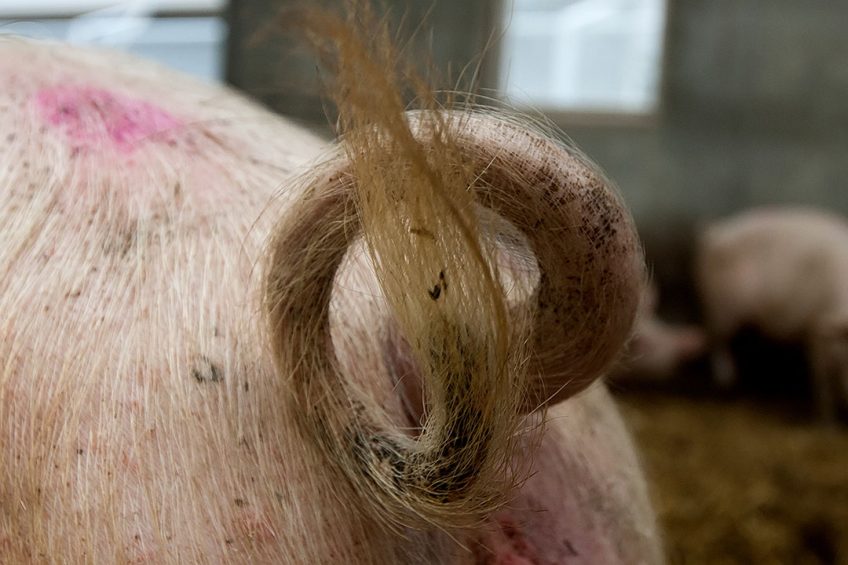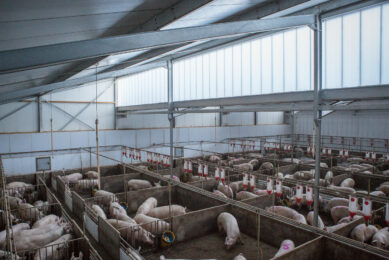Early indicators for tail biting in pigs

Should pigs in the EU keep the end of their tails, or should tails be docked in the 1st days of the pigs’ lives to reduce risk of tail biting? The subject is widely discussed which also underlines that there is no easy answer. However, there is work in progress and so are some very promising results, writes pig welfare expert Vivi Aarestrup Moustsen.
Recently, my colleague Helle Pelant Lahrmann, defended her PhD-thesis called, ‘Tail biting out-break in pigs – prevalence, early detection and targeted intervention’. In this Expert Opinion, I’ll outline some of the very interesting results from her study.
Tail biting in pigs is a major welfare challenge in modern pig production because the behaviour is unpredictable and can quickly spread within a group of pigs. To reduce tail biting, most pigs reared within the EU are tail docked. Tail docking, however, is a symptom-based treatment and does not remove the underlying causes triggering the abnormal behaviour.
Producing pigs with intact tails
Nevertheless, producing pigs with intact tails in current production systems is expected to lead to a dramatic increase in tail damaged pigs without changes in management routines and production principles. Now what to do?
The PhD study included 4 steps:
- The PhD-study documented what happens in a typical Danish grow-finishing unit, if pigs have not been tail docked and no specific interventions are made;
- The study addressed if there were early indicators of upcoming tail bite outbreaks and if they could be identified by the stockpersons;
- If signs of an upcoming outbreak were observed, could the outbreak be prevented; and
- If there was an outbreak any way, could the risk of the outbreak escalating be reduced.
In a well-managed finishing unit, tail damage prevalence was recorded in 48 pens with a total of 962 tail docked pigs and in 47 pens with a total of 960 undocked pigs. None of the docked pigs got a tail injury, whereas 23% of the undocked pigs got a tail injury. The undocked pigs with tail injury were distributed in 68% of the pens. The tail injuries were scored at the farm.
Observing undocked weaner pigs
Next, 2,301 undocked weaner pigs were observed. The pigs were distributed in 74 pens. Tails were scored 3 times weekly prior to a tail biting outbreak, where an outbreak was defined as 4 pigs in a pen with a tail wound. In addition to the manual observation of tail injuries, video cameras were placed above the pens and behaviour of the pigs were recorded.

Read other columns by Vivi Aarestrup Moustsen and our other experts
If a tail biting outbreak occurred, the behaviour of the pigs in pen prior to the outbreak was observed and registered. Results from the video scan sampling showed almost a doubling in the percentage of hanging tails in pens close to a tail biting outbreak.
There was no difference observed in activity, pigs at the feeder, exploratory behaviour, pen mate directed behaviour or tail directed behaviour between upcoming tail biting pens and pens with no tail biting outbreak occurring within the next week. The increase in hanging/tucked tails was also identified at direct observations from outside the pen.
Change in prevalence of hanging tails
The change in prevalence of hanging tails prior to an upcoming tail biting outbreak was the target of the next study where the aim was to document if early interventions in pens with hanging tails could reduce the risk of tail biting outbreak.
In 60 pens with a total of 1,804 undocked weaner pigs, early intervention treatment was provided when the 1st tail damaged pig or tucked tail was observed from outside the pen. The prevalence of tail biting outbreaks was reduced in pens provided with straw (200 g/pen) or haylage compared to pens with no early intervention (control group).

Amounts of straw against tail biting
In pens, where a tail biting outbreak did occur, it was recorded if provision of a small amount of straw, rope or a ‘bite-rite’ reduced the risk of tail biting outbreaks escalating. A small amount of straw prevented an escalation in tail injuries more efficiently than ‘bite-rite’. However, even when providing a small amount of straw, tail biting continued in approximately 1 in 4 four pens.
To sum up the results:
- Yes, tail biting will increase, if pigs are not docked and no interventions are made;
- However, prior to a tail biting outbreak, an increased prevalence of hanging tails can be identified from outside the pen;
- When an increase in prevalence of hanging tails are observed, the risk of a tail biting outbreak can be reduced by provision of smaller amounts of enrichment;
- If this is insufficient and a tail biting outbreak does occur, a continued provision of straw reduces the risk of the outbreak to escalate compared to a ‘bite-rite’.
And a very, very important ‘take home message’ is that it’s important to react to early indicators and tail injuries and not wait until the stage of bleeding tails. Compare it to putting out a fire – it is better to deal with the first spark than to try and put out a large bonfire.











